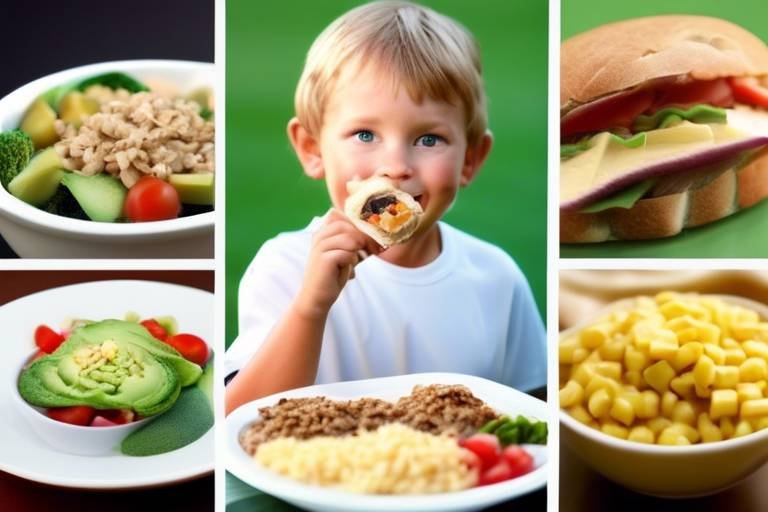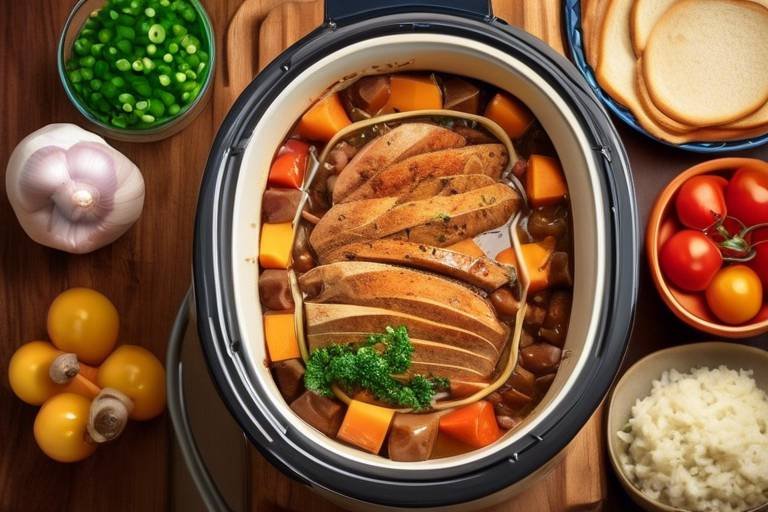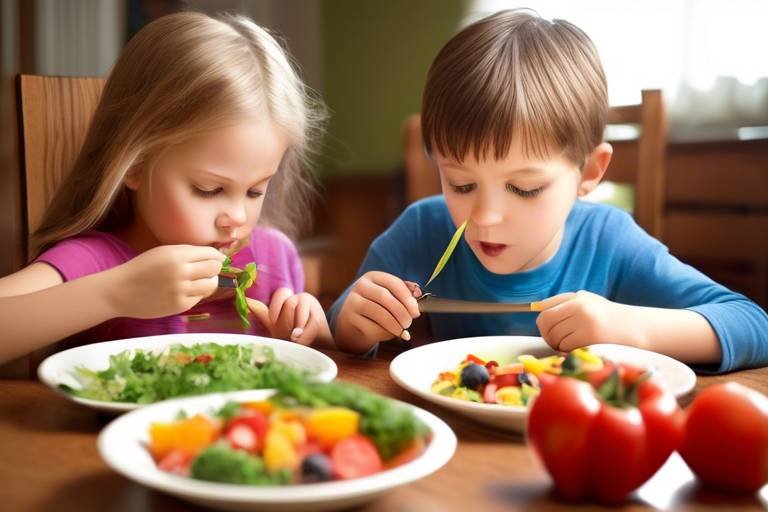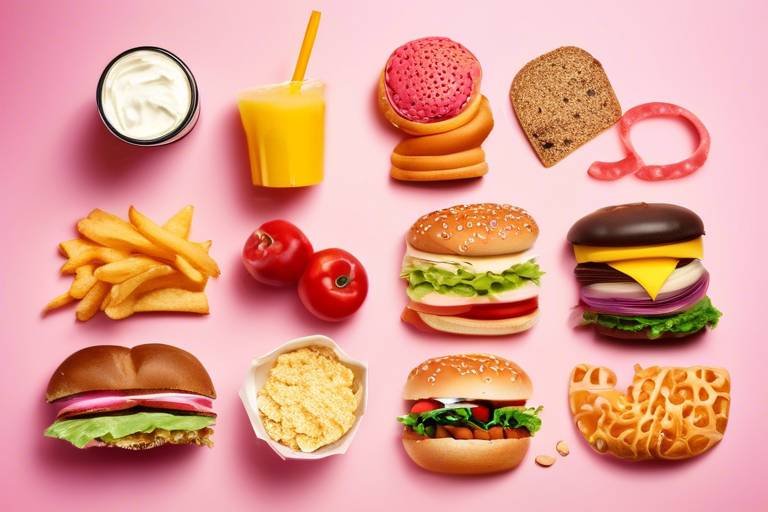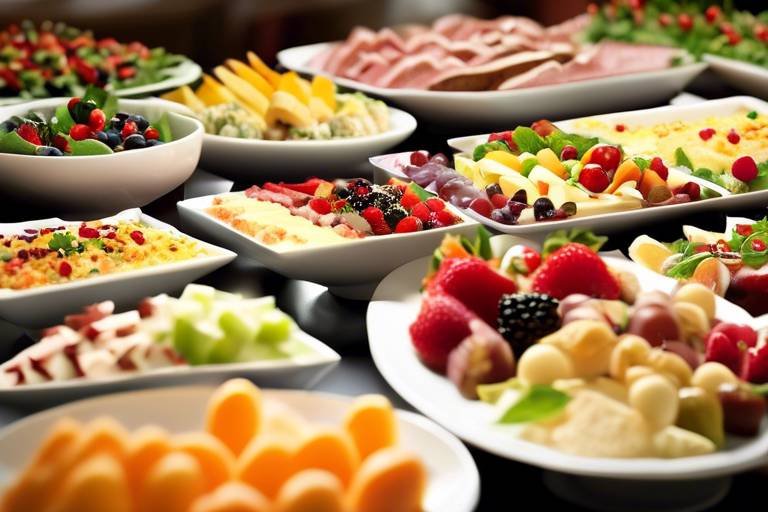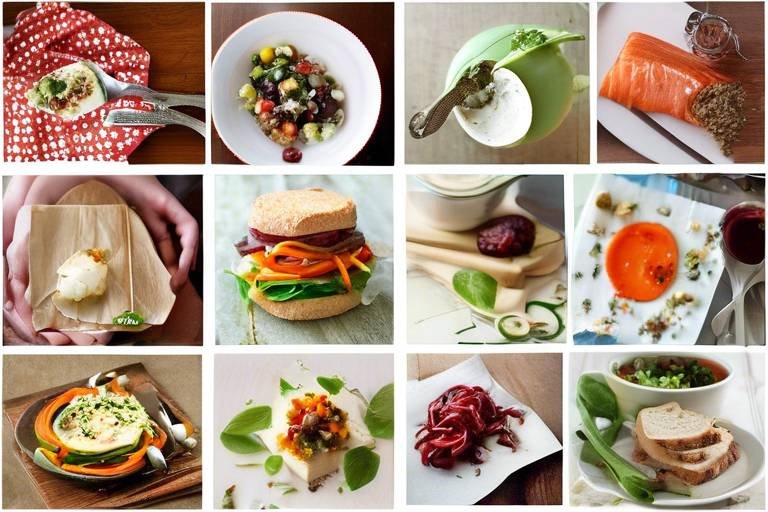Plant-Based Meal Ideas for the Whole Family
In today's fast-paced world, finding delicious and nutritious meal options for the whole family can be a challenge. However, embracing a plant-based diet opens up a world of culinary possibilities that not only cater to diverse tastes but also promote healthier eating habits. Imagine a dinner table filled with vibrant colors, tantalizing aromas, and flavors that excite every palate. Whether you have picky eaters or adventurous foodies at home, plant-based meals can be both satisfying and enjoyable. Let's dive into some fantastic meal ideas that will keep your family happy and healthy!
Before we jump into the meal ideas, it's essential to understand the numerous benefits of adopting a plant-based diet. Not only does this lifestyle choice improve heart health by reducing cholesterol levels, but it also aids in weight management and boosts energy levels. Families who embrace plant-based eating often report feeling more energetic and vibrant. Additionally, incorporating more fruits, vegetables, grains, and legumes into your meals can lead to a healthier lifestyle overall. So, why not make the switch and enjoy these benefits together as a family?
Starting the day with a nutritious breakfast is crucial for maintaining energy levels throughout the day. Luckily, there are plenty of simple plant-based breakfast ideas that even the pickiest eaters will love. Think about how a colorful breakfast can set a positive tone for the day. Here are a few ideas to get you started:
Smoothie bowls are not just a breakfast; they're a canvas for creativity! Blend your favorite fruits with a splash of plant-based milk, and pour it into a bowl. Then, let the kids decorate their bowls with toppings like granola, seeds, and fresh fruit. It’s a fun way for them to engage with their food, and you can sneak in some leafy greens without them even noticing!
Overnight oats are a lifesaver for busy mornings. Just mix rolled oats with almond milk, chia seeds, and a touch of maple syrup, then let them sit overnight. In the morning, add toppings like berries, nuts, or even a dollop of nut butter. It's a quick and customizable breakfast that can cater to everyone's preferences!
Avocado toast is a trendy breakfast option that’s here to stay! You can switch it up by adding various toppings. Try it with sliced tomatoes and a sprinkle of sea salt, or go for a sweet twist with banana and a drizzle of honey. The creamy avocado provides healthy fats that keep everyone feeling full and satisfied.
When it comes to lunch, it’s all about making it hearty and filling. Here are some plant-based lunch ideas that are perfect for school or work:
- Chickpea Salad Sandwiches: Mash chickpeas with avocado, diced celery, and a splash of lemon juice for a protein-packed sandwich filling.
- Quinoa Bowls: Mix cooked quinoa with black beans, corn, diced bell peppers, and a zesty lime dressing for a refreshing lunch.
- Veggie Wraps: Load up whole-grain wraps with hummus, spinach, shredded carrots, and sliced cucumbers for a crunchy delight.
Dinner time is when families come together, and it’s essential to have meals that everyone will enjoy. Here are some wholesome plant-based dinner recipes:
One-pot meals are a dream come true for busy families. They simplify cooking and cleanup while offering a variety of flavors. Think of a hearty vegetable stew or a chickpea curry served over rice. Just throw everything into one pot, let it simmer, and you’ve got a nutritious meal with minimal effort!
Pasta is a universal favorite, and you can easily make it plant-based. Try whole grain or lentil pasta tossed with a homemade tomato sauce loaded with vegetables. You can even sneak in some spinach or kale for added nutrition. It’s comforting, filling, and sure to please even the pickiest eaters!
Keeping kids energized between meals is vital, and healthy snacks can make all the difference. Here are a couple of ideas that are both nutritious and fun:
Energy balls are a fantastic way to fuel up on the go. Combine dates, nuts, and your choice of seeds in a food processor, roll them into bite-sized balls, and refrigerate. They're perfect for a quick snack that provides lasting energy!
Encourage kids to snack on fresh vegetables by pairing them with delicious dips. Homemade hummus is easy to make and can be flavored with garlic, roasted red peppers, or spices. Serve it with an array of colorful veggies for a snack that’s both fun and healthy!
Transitioning your family to a plant-based diet doesn’t have to be overwhelming. Start by introducing one or two plant-based meals a week and gradually increase from there. Involve your family in meal planning and preparation to make it a fun activity. Remember, it’s all about balance and variety. Keep experimenting with different flavors and textures until you find what works best for your family!
1. Is a plant-based diet suitable for children?
Yes! A well-planned plant-based diet can provide all the necessary nutrients for children and support their growth and development.
2. How can I ensure my family gets enough protein on a plant-based diet?
Incorporate a variety of protein sources such as beans, lentils, tofu, nuts, and whole grains into your meals to meet protein needs.
3. What are some easy ways to introduce plant-based meals to my family?
Start with familiar dishes, like spaghetti with marinara sauce, and gradually swap out ingredients for plant-based alternatives.
4. Can I still enjoy my favorite foods on a plant-based diet?
Absolutely! Many traditional recipes can be easily adapted to be plant-based without sacrificing flavor.

[Benefits of Plant-Based Eating]
Adopting a plant-based diet comes with a treasure trove of benefits that can transform not only your health but also your family's eating habits. Imagine a lifestyle where meals are not just about filling your stomach, but also about nourishing your body and boosting your overall well-being. Isn't that a dream come true? Let's dive into some of the most compelling reasons to embrace this vibrant way of eating.
First and foremost, one of the most significant advantages of plant-based eating is its positive impact on heart health. Studies have shown that diets rich in fruits, vegetables, whole grains, and legumes can lower cholesterol levels, reduce blood pressure, and decrease the risk of heart disease. Think of your heart as a car engine; just like a car runs better on high-quality fuel, your heart performs optimally when fed with nutritious, plant-based foods. This is especially important for families, as heart health is crucial for all ages.
Another noteworthy benefit is weight management. Plant-based diets tend to be lower in calories and higher in fiber, which can help you feel full longer. This means less snacking on unhealthy foods and more satisfaction from your meals. It’s like switching from a heavy, greasy meal to a light, refreshing salad that leaves you energized rather than sluggish. For families trying to maintain a healthy lifestyle, this can make a world of difference.
Moreover, plant-based eating can significantly enhance your energy levels. When you consume a diet rich in whole foods, your body gets the vitamins, minerals, and antioxidants it needs to function at its best. Imagine waking up each morning feeling refreshed and ready to conquer the day, rather than dragging yourself out of bed. This newfound energy can lead to more family activities, whether it’s hiking, biking, or simply playing in the yard.
Not only does a plant-based diet benefit individual health, but it also promotes a more sustainable way of living. By choosing plants over animal products, families can reduce their carbon footprint and contribute to a healthier planet. It’s like planting a tree; every small action adds up to create a bigger impact. As a family, you can bond over the shared goal of making environmentally-friendly choices.
In addition to these health benefits, transitioning to a plant-based diet can also encourage creativity in the kitchen. With a plethora of fruits, vegetables, grains, and legumes available, cooking becomes an exciting adventure rather than a mundane chore. Experimenting with new recipes and flavors can turn mealtime into a fun, family-oriented activity. You could even make it a game where each family member picks a new ingredient to try each week!
In summary, the benefits of plant-based eating are not just limited to health; they extend to energy levels, environmental impact, and even family bonding. By incorporating more plant-based meals into your family’s diet, you’re not just making a choice for better health, but also creating lasting memories around the dinner table. So why not give it a try? Your body, your family, and the planet will thank you!
- What are some easy plant-based meals for beginners? Start with simple dishes like vegetable stir-fries, salads, and smoothies. These are not only easy to prepare but also delicious!
- Can children thrive on a plant-based diet? Absolutely! With proper planning, children can get all the nutrients they need from a variety of plant-based foods.
- How do I transition my family to a plant-based diet? Start slowly by introducing one or two plant-based meals a week, and gradually increase as everyone becomes more comfortable with the changes.

[Quick and Easy Breakfast Options]
Starting the day with a nutritious breakfast can set the tone for a successful day ahead. But let’s face it, mornings can be chaotic, especially in a busy household. That’s why quick and easy plant-based breakfast options are a game-changer! Imagine a breakfast that not only fuels your family but also pleases their taste buds. With a little creativity and a few simple ingredients, you can whip up meals that are both satisfying and healthy.
One of the easiest ways to kick off your day is with smoothie bowls. These vibrant bowls are a feast for the eyes and the taste buds! You can blend your favorite fruits—think bananas, berries, and spinach—into a creamy base and then top it off with crunchy granola, seeds, and even a drizzle of nut butter. Not only are they packed with nutrients, but they also allow for endless customization. Want to make it a little sweeter? Toss in some dates or a splash of maple syrup. The best part? Kids love to help create their own unique smoothie bowl, making breakfast a fun family activity!
| Ingredients | Instructions |
|---|---|
|
1. Blend the banana, spinach, almond milk, and mixed berries until smooth. 2. Pour into a bowl and decorate with your favorite toppings. |
Another fantastic option is overnight oats. This breakfast can be prepared the night before, making it a perfect choice for those rushed mornings. Simply combine rolled oats with your favorite plant-based milk and toppings like fruits, nuts, or even a spoonful of nut butter. Let it sit overnight in the fridge, and voilà! You have a delicious, creamy breakfast waiting for you in the morning. Plus, the flavor combinations are endless—try adding cinnamon and apples for a cozy fall vibe or cacao powder and bananas for a chocolatey treat!
| Ingredients | Instructions |
|---|---|
|
1. In a jar, mix the oats, almond milk, chia seeds, and maple syrup. 2. Stir well, then top with banana slices. 3. Cover and refrigerate overnight. |
And let’s not forget about the classic avocado toast. This trendy breakfast option is not just a pretty picture on social media; it’s incredibly nutritious and versatile! You can simply mash some ripe avocado on whole grain bread and add toppings like cherry tomatoes, radishes, or even a sprinkle of nutritional yeast for a cheesy flavor. It’s a great way to get healthy fats and fiber in your morning routine. Plus, kids can get involved by choosing their favorite toppings, making breakfast a creative outlet!
With these quick and easy breakfast options, you’re not just feeding your family; you’re also creating a positive relationship with food. Breakfast can be a delightful experience that nourishes both the body and the soul. So why not mix it up and let everyone in the family choose their favorite meal? After all, healthy eating should be fun and enjoyable!
1. Can I prepare these meals ahead of time?
Absolutely! Smoothie bowls can be prepped in advance, and overnight oats are designed to be made the night before. Just grab and go!
2. Are these meals suitable for kids?
Yes! All these options are kid-friendly and can be customized to suit different tastes, making them perfect for even the pickiest eaters.
3. What if my family doesn’t like certain ingredients?
Don’t worry! You can easily swap out fruits, nuts, or toppings based on your family’s preferences. The key is to experiment and find combinations that everyone loves!

[Smoothie Bowls]
Smoothie bowls are not just a breakfast; they are a canvas for creativity and a feast for the eyes! Imagine starting your day with a bowl filled with vibrant colors, textures, and flavors that make you feel like you're indulging in a dessert rather than a healthy meal. These bowls are a fantastic way to get your family excited about breakfast, especially for those picky eaters who might shy away from traditional options. The beauty of smoothie bowls lies in their versatility; you can mix and match ingredients based on your family's preferences and what you have on hand.
To create a delightful smoothie bowl, start with a base of your favorite fruits and vegetables. Common choices include bananas, spinach, and berries, which blend together to create a creamy and delicious foundation. You can use a high-speed blender to achieve that perfect, smooth consistency. The fun part comes next: toppings! You can pile on a variety of toppings that not only add flavor but also a crunch that makes every bite exciting. Think granola, chia seeds, coconut flakes, and fresh fruit slices. The combination of textures will make your smoothie bowl a hit with both kids and adults.
Here's a simple recipe to get you started:
| Ingredients | Quantity |
|---|---|
| Frozen Bananas | 1 cup |
| Spinach | 1 cup |
| Almond Milk (or any plant-based milk) | 1/2 cup |
| Chia Seeds | 2 tablespoons |
| Granola | 1/4 cup |
| Fresh Berries | 1/2 cup |
To prepare, simply blend the frozen bananas, spinach, and almond milk until smooth. Pour the mixture into a bowl and let your kids go wild with the toppings! They can create their own masterpiece, which not only makes breakfast fun but also encourages them to eat healthier. Plus, you can sneak in some greens without them even noticing! The possibilities are endless, and you can even switch up the ingredients based on the season or what’s available in your fridge.
So, why not turn breakfast into an art project? Smoothie bowls are not just nutritious; they are a delightful way to kick off your family's day with energy and joy. And who knows? You might even find yourself looking forward to breakfast just as much as your kids do!

[Overnight Oats]
Overnight oats are not just a trendy breakfast option; they are a game-changer for busy families! Imagine waking up to a delicious and nutritious meal that you prepared the night before. Sounds dreamy, right? With overnight oats, you can mix and match ingredients to cater to everyone’s taste buds, making breakfast a delightful experience for the whole family.
To get started, all you need is a base of rolled oats, your choice of plant-based milk (like almond, oat, or soy), and a few fun toppings. The beauty of overnight oats lies in their versatility. You can create a different flavor every day of the week! For instance, you might choose a classic banana and peanut butter combo one morning, then switch to a tropical coconut and mango delight the next. The options are truly endless!
Here’s a simple way to prepare them:
Ingredients: - 1 cup rolled oats - 1 cup plant-based milk - 1 tablespoon chia seeds (optional for extra nutrition) - Sweetener to taste (like maple syrup or agave) - Your favorite fruits, nuts, or seeds for topping
Simply combine the oats, milk, chia seeds, and sweetener in a jar or bowl. Stir well, cover, and refrigerate overnight. In the morning, just add your toppings, and voilà! You have a delicious breakfast ready in seconds. It’s like having a little surprise waiting for you each morning!
For those with kids, let them get involved in the process. They can choose their favorite toppings, which not only makes them excited about breakfast but also encourages them to try new flavors. Plus, it’s a fantastic way to teach them about healthy eating habits from a young age. You might find that they prefer their oats with a sprinkle of cinnamon and sliced apples or perhaps a handful of berries and a drizzle of almond butter.
In addition to being delicious, overnight oats are packed with nutrients. They provide a great source of fiber, which aids digestion and keeps everyone feeling full until lunch. Plus, with the right mix of toppings, they can be a powerhouse of vitamins and minerals, making them a perfect start to the day.
So, why not give overnight oats a try? They are not only quick and easy to prepare, but they also offer a delightful way to enjoy a healthy breakfast that the whole family will love. Who knew that breakfast could be so simple and yet so satisfying?
Q: Can I prepare overnight oats for multiple days at once?
A: Absolutely! You can make several jars of overnight oats at once and store them in the refrigerator for up to five days. Just remember to add fresh toppings right before eating!
Q: What if I don’t have chia seeds?
A: No worries! Chia seeds are optional. They help thicken the oats and add some extra nutrition, but you can still enjoy your overnight oats without them.
Q: Can I use instant oats instead of rolled oats?
A: While you can use instant oats, they may become mushy if left to soak overnight. Rolled oats are recommended for the best texture.
Q: Are overnight oats gluten-free?
A: Yes, as long as you use gluten-free oats, overnight oats can be a great option for those with gluten sensitivities.

[Avocado Toast Variations]
Avocado toast has become a breakfast staple for many, and it's no wonder why! This simple yet delicious dish is not only quick to prepare but also offers endless possibilities for customization. Imagine starting your day with a slice of perfectly toasted bread topped with creamy avocado, bursting with flavor and nutrients. But why stop there? Let's explore some exciting variations that will make your avocado toast the star of the breakfast table!
First off, consider the classic avocado and tomato combination. Slice up some juicy heirloom tomatoes and layer them on top of your mashed avocado. Sprinkle a little sea salt and fresh basil for that extra kick. The freshness of the tomatoes paired with the rich creaminess of the avocado creates a delightful balance that will have your taste buds dancing.
If you're feeling adventurous, why not try a spicy twist? Add a sprinkle of red pepper flakes or a drizzle of sriracha on top of your avocado toast. This combination not only adds heat but also elevates the overall flavor profile. Pair it with a squeeze of lime, and you’ll have a zesty breakfast that packs a punch!
For those who love a bit of sweetness in their morning meal, consider the avocado and banana option. Spread your mashed avocado on toast and top it with banana slices. Drizzle a little honey or maple syrup on top, and you have a sweet yet nutritious breakfast that will keep you energized throughout the morning.
Another fantastic variation is the Mediterranean style. Top your avocado toast with crumbled feta cheese, olives, and a sprinkle of oregano. This combination not only adds a burst of flavor but also gives your toast a beautiful presentation. Serve it with a side of cherry tomatoes for a refreshing touch!
And let’s not forget about the power of greens. Add a handful of arugula or spinach on top of your avocado toast for a nutrient boost. The peppery flavor of arugula complements the creaminess of the avocado perfectly, making it a delightful addition to your breakfast routine.
To make things even more interesting, you can create a DIY avocado toast bar for the family! Set out a variety of toppings such as sliced radishes, pickled onions, nuts, seeds, and different herbs. Let everyone build their own unique toast masterpiece. It’s a fun way to get the whole family involved in breakfast preparation and ensures that everyone gets to enjoy their favorite flavors.
In conclusion, avocado toast is incredibly versatile and can be tailored to suit any palate. Whether you prefer it savory, spicy, sweet, or with a hint of freshness, the possibilities are endless. So next time you're in the kitchen, don’t hesitate to experiment with different toppings and flavors. Who knows? You might just stumble upon your new favorite breakfast!
Q: Can I use frozen avocados for avocado toast?
A: Yes, frozen avocados can be used! Just thaw them and mash them up. They may not be as creamy as fresh avocados, but they’ll still taste great!
Q: What type of bread is best for avocado toast?
A: Whole grain, sourdough, or gluten-free bread are all excellent choices. Choose what you enjoy the most!
Q: How can I keep my avocado from browning?
A: To prevent browning, squeeze some lemon or lime juice over the mashed avocado before spreading it on your toast.
Q: Can I prepare avocado toast in advance?
A: While the toast can be made ahead, it’s best to prepare the avocado just before serving to keep it fresh and green.

[Plant-Based Lunch Ideas]
When it comes to lunchtime, the challenge often lies in finding meals that are not only nutritious but also appealing to the entire family. Plant-based lunches can be a delightful adventure filled with flavors and textures that please even the pickiest eaters. Imagine sinking your teeth into a hearty chickpea salad sandwich or savoring a warm bowl of quinoa and black bean chili. These meals are not just healthy; they're bursting with personality and can be prepared in a snap!
One of the best things about plant-based lunches is their versatility. You can mix and match ingredients to cater to everyone's tastes. For instance, consider a wrap filled with roasted vegetables, hummus, and fresh greens. Wrap it up, and you’ve got a colorful, portable meal that’s easy to eat on the go! Or how about a delightful rice bowl? Start with a base of brown rice or quinoa, then pile on your favorite veggies, beans, and a drizzle of tahini or a zesty dressing. The options are endless!
Another fantastic idea is to prepare stuffed bell peppers. These vibrant veggies can be filled with a mixture of lentils, spices, and grains, then baked until tender. Not only do they look stunning on the plate, but they also provide a wholesome meal that’s packed with nutrients. If you're looking for something even quicker, consider vegan sushi rolls. Using nori sheets, simply roll up avocado, cucumber, and carrots, and you have a fresh and fun lunch that’s sure to excite the kids.
For those busy mornings, meal prep can be your best friend. Spend a little time on the weekend to prepare a batch of plant-based chili or a big pot of vegetable soup. These dishes can be portioned out and stored in the fridge or freezer, ready to be heated up for a quick lunch. Pair them with a slice of whole-grain bread, and you have a satisfying meal that requires minimal effort during the week.
Let’s not forget the power of salads. A well-crafted salad can be a filling and nutritious option. Start with a base of leafy greens, then add a variety of toppings such as roasted chickpeas, nuts, seeds, and a colorful array of veggies. Don’t skimp on the dressing; a homemade vinaigrette can elevate your salad to an entirely new level. You might even find that your kids enjoy creating their own salad masterpieces, making lunchtime a fun and engaging experience!
In summary, plant-based lunches can be as exciting as they are healthy. By embracing a variety of ingredients and preparation methods, you can ensure that every family member finds something they love. Whether it’s a hearty wrap, a vibrant rice bowl, or a creative salad, the key is to keep it fun and flavorful. So, what are you waiting for? Dive into the world of plant-based lunches and watch your family’s taste buds dance with joy!

[Family-Friendly Dinner Recipes]
When it comes to dinner time, the challenge is often finding meals that everyone in the family will enjoy. Thankfully, plant-based eating offers a treasure trove of delicious and satisfying options that can cater to even the pickiest of eaters. Imagine a table filled with vibrant colors, enticing aromas, and flavors that dance on your palate. It’s not just about filling bellies; it’s about creating joyful experiences around the dinner table. Here are some fantastic family-friendly dinner recipes that are sure to please!
First up, let’s talk about one-pot meals. These are the superheroes of the dinner world! Not only do they save you time on cooking and cleanup, but they also pack a punch in terms of flavor and nutrition. Picture this: a hearty vegetable stew simmering on the stove, filled with seasonal veggies, lentils, and aromatic herbs. It’s a meal that warms the soul and fills the stomach. You can easily customize it with whatever you have on hand, making it a flexible option for busy weeknights.
Now, if your family loves pasta (and who doesn’t?), you’re in for a treat with creative plant-based pasta dishes. Try whipping up a creamy cashew Alfredo sauce tossed with whole grain spaghetti and topped with sautéed mushrooms and spinach. It’s a comforting dish that feels indulgent but is packed with nutrients. The kids will never guess they’re eating something healthy! For a fun twist, you can even use spiralized vegetables like zucchini or carrots as a pasta substitute to sneak in even more veggies.
Another delightful option is a chickpea curry. This dish is not only easy to make but also incredibly flavorful. By simmering chickpeas with coconut milk, diced tomatoes, and a blend of spices, you create a rich and creamy sauce that pairs beautifully with brown rice or quinoa. Serve it with some naan bread for a complete meal that everyone will love. Plus, it’s a fantastic way to introduce your family to new flavors without overwhelming their taste buds.
For those nights when you want something a bit lighter, consider making a stuffed bell pepper dish. You can fill bell peppers with a mixture of quinoa, black beans, corn, and spices, then bake them until tender. Not only do they look beautiful on the plate, but they also offer a balanced meal in a single serving. It's like a little edible treasure waiting to be discovered!
To make your dinner planning even easier, here’s a quick table summarizing these family-friendly dinner recipes:
| Recipe | Main Ingredients | Cooking Time |
|---|---|---|
| Vegetable Stew | Seasonal veggies, lentils, herbs | 30 minutes |
| Creamy Cashew Alfredo Pasta | Cashews, whole grain pasta, mushrooms, spinach | 20 minutes |
| Chickpea Curry | Chickpeas, coconut milk, spices | 25 minutes |
| Stuffed Bell Peppers | Quinoa, black beans, corn | 40 minutes |
As you can see, these recipes not only bring flavor to the table but also make dinnertime a fun and engaging experience for the whole family. Whether you’re cooking for kids or adults, these meals are designed to be enjoyed by all, making plant-based eating a delightful adventure. So, roll up your sleeves and get ready to create some delicious memories!
Q: Are plant-based meals expensive?
A: Not necessarily! Plant-based meals can be very budget-friendly, especially when you focus on whole foods like beans, grains, and seasonal vegetables.
Q: How can I ensure my family gets enough protein on a plant-based diet?
A: Incorporate a variety of protein sources such as beans, lentils, tofu, tempeh, and quinoa into your meals. Combining these with whole grains can provide a complete protein profile.
Q: What if my kids are picky eaters?
A: Start by introducing new foods gradually and combine them with familiar favorites. Making meals fun, like creating colorful smoothie bowls or engaging them in the cooking process, can help pique their interest.

[One-Pot Meals]
When it comes to family dinners, one-pot meals are a game changer. They combine convenience with flavor, making them perfect for busy weeknights when you want to whip up something delicious without spending hours in the kitchen. Imagine a hearty stew or a savory rice dish that cooks all in one pot, allowing the flavors to meld beautifully while you enjoy quality time with your family. Plus, the cleanup is a breeze—just one pot to wash!
One-pot meals are not only easy to prepare, but they can also be incredibly nutritious. By using a variety of vegetables, legumes, and whole grains, you can create a balanced meal that satisfies even the pickiest eaters. For instance, consider a chickpea and spinach curry that simmers gently, allowing the spices to infuse the dish with warmth and depth. Or, how about a vegetable quinoa pilaf that’s packed with protein and fiber? The possibilities are endless, and the best part is that you can tailor each recipe to suit your family's preferences.
Here’s a simple recipe to get you started:
| Dish | Ingredients | Cooking Time |
|---|---|---|
| Chickpea and Spinach Curry |
|
30 minutes |
To make this delightful curry, start by sautéing the onion and garlic in a pot until they're golden brown. Add the curry powder and stir for a minute—this helps to release the spices' aroma. Then, toss in the chickpeas and coconut milk, letting everything simmer together for about 15 minutes. Finally, fold in the fresh spinach until wilted, season with salt and pepper, and voilà! You have a warming dish that’s ready to be served over rice or quinoa.
Another fantastic option is a one-pot pasta dish. Picture a creamy tomato basil pasta that cooks all in one pot, absorbing all the flavors as it simmers. You simply add your pasta, diced tomatoes, vegetable broth, and seasonings to the pot, cover it, and let it work its magic. In about 20 minutes, you’ll have a comforting meal that feels indulgent yet is packed with wholesome ingredients.
One-pot meals are also a wonderful opportunity to involve your kids in the cooking process. They can help wash the vegetables, measure out ingredients, and even stir the pot. Not only does this make mealtime more interactive, but it also encourages them to try new foods. After all, when they help prepare the meal, they’re more likely to want to eat it!
In summary, one-pot meals are an excellent way to bring the family together at the dinner table. They’re simple, nutritious, and bursting with flavor, making them a staple in any plant-based kitchen. So why not give them a try? You might just find that they become your new favorite go-to for family dinners.
1. What are some other examples of one-pot meals?
Some popular one-pot meals include vegetable stir-fry, lentil soup, and risotto. You can get creative and mix different ingredients based on what your family enjoys!
2. Can I make one-pot meals in advance?
Absolutely! Many one-pot meals can be prepared in advance and stored in the refrigerator. Just reheat when you're ready to eat!
3. Are one-pot meals healthy?
Yes! One-pot meals can be very healthy, especially when you incorporate a variety of vegetables, whole grains, and legumes. Just be mindful of the ingredients you choose.
4. How do I prevent my one-pot meals from becoming too watery?
To avoid a watery dish, make sure to follow the recommended liquid ratios in recipes and keep an eye on the cooking time. You can always simmer longer to reduce excess liquid.

[Creative Pasta Dishes]
Pasta is a beloved staple in many households, and the great news is that it can be easily transformed into delicious plant-based meals that cater to every family member's taste buds. Whether you're a fan of classic Italian flavors or looking to experiment with global cuisines, there are countless ways to make pasta exciting and nutritious. Imagine twirling your fork into a bowl of vibrant, colorful noodles that not only look good but are also packed with nutrients!
One fantastic option is to create a creamy avocado pasta. Simply blend ripe avocados with garlic, lemon juice, and a touch of olive oil to create a luscious sauce. Toss this with your favorite pasta and add cherry tomatoes and spinach for a burst of flavor and color. It's like a hug in a bowl, and the kids will love it! Plus, avocados are rich in healthy fats, making this dish both satisfying and nourishing.
If you’re in the mood for something a bit more adventurous, try making zucchini noodles, also known as zoodles. This is a fun way to sneak in some extra veggies while keeping the meal light and fresh. You can spiralize zucchini into noodle shapes and sauté them briefly, then toss with a homemade tomato sauce or pesto. This dish is not only low in carbs but also a fantastic way to introduce kids to new textures and flavors without overwhelming them.
For those who enjoy a bit of spice, consider a Thai-inspired peanut noodle dish. Cook your pasta of choice and toss it with a sauce made from peanut butter, soy sauce, lime juice, and a hint of sriracha. Add in some crunchy veggies like bell peppers and carrots, and top it off with crushed peanuts and cilantro. This dish is a flavor explosion that will have everyone reaching for seconds!
Another creative idea is to prepare a mushroom and spinach pasta. Sauté a mix of your favorite mushrooms with garlic and olive oil, then add fresh spinach until wilted. Combine this with whole-grain pasta and a sprinkle of nutritional yeast for a cheesy flavor without the dairy. This dish is hearty and satisfying, making it perfect for a family dinner.
To make things even more interesting, you can host a pasta night where everyone can customize their own dishes. Set up a variety of sauces, vegetables, and toppings. This not only encourages creativity but also allows each family member to choose what they love most. It's a fun way to engage everyone in the cooking process and make mealtime a delightful experience.
Ultimately, the key to creating exciting plant-based pasta dishes is to experiment with flavors and textures. The possibilities are endless, and with a bit of creativity, you can turn a simple bowl of pasta into a culinary adventure that everyone in the family will enjoy!
Q: Can I use gluten-free pasta in these recipes?
A: Absolutely! There are many gluten-free pasta options available, such as those made from rice, quinoa, or chickpeas. They work beautifully in any of these dishes.
Q: How can I add protein to my plant-based pasta dishes?
A: You can incorporate protein by adding ingredients like chickpeas, lentils, or tofu. Nuts and seeds also make great toppings for added crunch and nutrition.
Q: Are these pasta dishes kid-friendly?
A: Yes! Many of these dishes can be tailored to suit kids' tastes. For instance, you can adjust the spice levels or let them choose their favorite toppings.
Q: Can I meal prep these pasta dishes?
A: Definitely! Many of these recipes can be made in advance and stored in the fridge. Just reheat and enjoy on busy weeknights!

[Healthy Snacks for Kids]
When it comes to keeping our little ones energized and satisfied between meals, healthy snacks are essential. Not only do they help maintain energy levels, but they also play a crucial role in developing good eating habits. But let’s face it, getting kids to choose healthy options can sometimes feel like trying to get a cat to take a bath. So, how can we make healthy snacking both fun and appealing? The secret lies in creativity and presentation!
One fantastic option is fruit and nut energy balls. These little bites of goodness are not only easy to make but also packed with nutrients. You can whip them up in no time by blending dates, nuts, and a splash of vanilla. The best part? You can customize them with your child’s favorite flavors! Think about adding cocoa powder for a chocolatey twist or a sprinkle of coconut for a tropical vibe. Kids love to help roll the balls, making it a fun family activity.
Another great idea is to create a colorful platter of veggie dips and hummus. Not only does this encourage kids to munch on fresh vegetables, but it also allows for a variety of flavors and textures. You can serve crunchy carrots, vibrant bell peppers, and crisp cucumbers alongside a few different dips. From classic hummus to a zesty avocado dip, the options are endless! Plus, the more colorful the plate, the more likely kids are to dive in. It’s like serving a rainbow on a platter!
To make snacking even more exciting, consider involving your kids in the preparation process. This not only teaches them about healthy eating but also gives them a sense of ownership over their food choices. For instance, you can have a snack-making station at home where they can assemble their own snacks. This could include whole-grain crackers, nut butter, and various toppings like banana slices, chia seeds, or even a drizzle of honey. The options are limitless, and the result is a snack that’s not only nutritious but also tailored to their taste!
Here's a quick table summarizing some healthy snack ideas that kids are sure to love:
| Snack | Main Ingredients | Health Benefits |
|---|---|---|
| Fruit and Nut Energy Balls | Dates, nuts, seeds | High in fiber and healthy fats |
| Veggie Dips and Hummus | Fresh veggies, chickpeas | Rich in vitamins and protein |
| Yogurt Parfaits | Greek yogurt, fruits, granola | Good source of calcium and probiotics |
| Whole-Grain Crackers with Nut Butter | Whole-grain crackers, nut butter | Provides energy and keeps hunger at bay |
Incorporating these healthy snacks into your family’s routine can transform the way your kids view food. Instead of seeing snacks as a guilty pleasure, they’ll begin to associate them with energy, fun, and creativity. And remember, the goal is to make healthy eating an enjoyable experience, not a chore. With a little imagination, you can turn snack time into a delightful adventure that your kids will look forward to every day!
Q: How can I get my kids to try new healthy snacks?
A: Involve them in the preparation process and make it fun! Let them choose ingredients and create their own snacks.
Q: Are store-bought snacks healthy?
A: Some store-bought snacks can be healthy, but it's essential to read labels and choose options with minimal added sugars and preservatives.
Q: How can I make healthy snacks more appealing?
A: Presentation is key! Use colorful plates, fun shapes, and creative arrangements to make snacks visually appealing.

[Fruit and Nut Energy Balls]
If you're looking for a quick, nutritious snack that your kids will love, fruit and nut energy balls are a fantastic option! These little bites of goodness are not only easy to make, but they also pack a powerful punch of energy and nutrients. Imagine having a snack that is both delicious and healthy, and can be prepared in just a few minutes. Sounds like a win-win, right?
To make these energy balls, all you need are a few simple ingredients. The base typically consists of nuts, which provide healthy fats and protein, and fruits, which add natural sweetness and fiber. You can customize them with a variety of add-ins such as seeds, oats, or even a sprinkle of chocolate chips for that extra treat! The best part? You can get the kids involved in the kitchen—it's a fun way to teach them about healthy eating.
Here's a basic recipe to get you started:
| Ingredients | Quantity |
|---|---|
| Rolled oats | 1 cup |
| Nut butter (e.g., almond or peanut) | 1/2 cup |
| Honey or maple syrup | 1/4 cup |
| Dried fruits (e.g., raisins, cranberries) | 1/2 cup |
| Chopped nuts (e.g., almonds, walnuts) | 1/2 cup |
| Chia seeds (optional) | 2 tablespoons |
To prepare, simply mix all the ingredients in a large bowl until well combined. Once the mixture has come together, roll it into small balls—about the size of a tablespoon. Place them on a baking sheet and refrigerate for at least 30 minutes to firm up. After that, they're ready to be enjoyed! These energy balls can be stored in an airtight container in the fridge for up to a week, making them an ideal snack for busy days.
Not only are they nutritious, but they also serve as a great source of energy for active kids. Think of them as mini power-ups, perfect for a post-school snack or a pre-sports boost. Plus, you can experiment with different combinations of fruits and nuts to keep things exciting. The possibilities are endless!
So, why not give these fruit and nut energy balls a try? Your family will love them, and you'll feel great knowing you're providing a healthy, homemade snack that fuels their adventures. It's a simple, fun, and delicious way to promote healthy eating habits in your household.
Q: Can I use different types of nuts?
A: Absolutely! Feel free to mix and match your favorite nuts or even use nut alternatives like sunflower seed butter for nut-free options.
Q: How long do these energy balls last?
A: They can be stored in an airtight container in the refrigerator for up to one week. You can also freeze them for longer storage—just let them thaw before enjoying!
Q: Can I add protein powder to the recipe?
A: Yes, adding a scoop of your favorite protein powder can enhance the nutritional value and make them even more filling.

[Veggie Dips and Hummus]
When it comes to keeping kids engaged in healthy eating, veggie dips and hummus are nothing short of a game changer. Imagine a colorful platter filled with fresh vegetables, each one waiting to be dunked into a creamy, flavorful dip. Not only do these dips make veggies more appealing, but they also pack a nutritional punch that can help your family maintain energy levels throughout the day. Plus, they’re incredibly easy to prepare, making them a perfect addition to any meal or snack time.
Hummus, the star of the show, is made primarily from chickpeas, which are rich in protein and fiber. This dip can be easily customized to suit your family's taste buds. Want something zesty? Add some lemon juice and garlic. Prefer a smokier flavor? Toss in some roasted red peppers. The beauty of hummus is that it can be as simple or as elaborate as you want it to be. You can even involve your kids in the process—let them choose their favorite ingredients and help blend them together!
But hummus isn’t the only dip worthy of your attention. There are countless veggie dips that can turn snack time into a fun and interactive experience. Here are a few ideas:
- Guacamole: Creamy avocado mixed with lime, cilantro, and tomatoes makes for a delicious dip that pairs perfectly with crunchy veggies.
- Yogurt-Based Dips: Greek yogurt mixed with herbs and spices creates a refreshing dip that’s high in protein and low in calories.
- Spinach and Artichoke Dip: A warm, cheesy dip that’s a hit at parties and can be made healthier with a few tweaks.
To make your veggie platter even more enticing, consider the presentation. Arrange the vegetables in a rainbow pattern to catch the eye. Think vibrant carrots, crisp cucumbers, and sweet bell peppers. Not only does this make for a visually appealing dish, but it also encourages your kids to try a variety of colors, which often corresponds to a range of nutrients.
In addition to being a hit with the kids, veggie dips and hummus can also serve as a great way for adults to enjoy healthy snacks without feeling deprived. Whether it’s a casual family movie night or a gathering with friends, these dips can elevate any occasion. Serve them with whole-grain pita chips, sliced bread, or even whole-grain crackers for a satisfying crunch.
Here’s a quick recipe to get you started with a basic hummus:
Simple Hummus Recipe - 1 can (15 oz) chickpeas, drained and rinsed - 2 tablespoons tahini - 2 tablespoons olive oil - Juice of 1 lemon - 1 clove garlic, minced - Salt to taste - Water to thin (if necessary) Blend all ingredients in a food processor until smooth. Adjust seasoning and consistency with water as needed. Serve with your favorite veggies!
So, the next time you’re looking for a way to make healthy eating fun and engaging for your family, remember the power of veggie dips and hummus. They’re not just dips; they’re a way to bring everyone together around the table, encouraging healthy habits that can last a lifetime. Plus, who can resist a colorful platter of fresh veggies waiting to be dunked? It’s a win-win!
Q: Can I make hummus without tahini?
A: Absolutely! You can omit tahini and still have a delicious hummus. You might want to add a bit more olive oil or a nut butter to maintain creaminess.
Q: How long can I store homemade hummus?
A: Homemade hummus can typically be stored in the refrigerator for about 4-7 days. Just make sure to keep it in an airtight container.
Q: What are some good vegetables to serve with dips?
A: Some great options include carrots, celery, bell peppers, cucumbers, cherry tomatoes, and radishes. The crunchier, the better!

[Tips for Transitioning to Plant-Based]
Transitioning to a plant-based diet can feel like a daunting task, especially if you’re used to a different way of eating. But fear not! With a sprinkle of patience and a dash of creativity, you can make this journey enjoyable for the whole family. The key is to approach the transition as a gradual process rather than an overnight overhaul. Start by incorporating more plant-based meals into your weekly menu. For instance, why not designate a couple of days as "Meatless Mondays"? This not only makes the transition manageable but also gives your family something to look forward to each week.
Another effective strategy is to involve your family in the meal planning and preparation process. When everyone participates, they’re more likely to embrace the changes. Have a family cooking night where you explore new recipes together. This can be a fun way to bond and introduce exciting flavors. You might be surprised at how much your kids enjoy experimenting with different fruits, vegetables, and grains. Plus, it gives them a sense of ownership over their meals, making them more inclined to try new things.
Don’t forget to keep the pantry stocked with plant-based staples. Having a variety of grains, legumes, nuts, and seeds on hand makes it easier to whip up quick meals. Consider creating a simple table of essentials to guide your shopping trips:
| Food Group | Examples |
|---|---|
| Grains | Quinoa, brown rice, oats, whole wheat pasta |
| Legumes | Chickpeas, lentils, black beans, kidney beans |
| Nuts & Seeds | Almonds, chia seeds, sunflower seeds, walnuts |
| Fruits & Vegetables | Spinach, kale, berries, bananas, carrots |
As you transition, it’s also essential to educate your family about the benefits of a plant-based diet. Discuss how it can lead to better health, increased energy, and even a positive impact on the environment. This knowledge can motivate everyone to embrace the changes. You might even explore documentaries or books together that highlight the advantages of plant-based eating.
Lastly, remember that it’s okay to have some slip-ups along the way. Transitioning is a journey, not a race. Celebrate small victories and don’t be too hard on yourself or your family if you occasionally fall back into old habits. The goal is to create a sustainable lifestyle that everyone enjoys. So, keep it fun, keep it flexible, and watch as your family flourishes on this exciting new path!
Q: How can I get my kids to eat more vegetables?
A: Get creative with presentation! Try making veggie faces on plates or incorporating vegetables into smoothies. Also, involve them in cooking to pique their interest.
Q: What are some easy plant-based meals for beginners?
A: Start with simple recipes like vegetable stir-fries, bean tacos, or pasta with marinara and veggies. These dishes are easy to prepare and full of flavor.
Q: Is it expensive to eat plant-based?
A: It can be budget-friendly! Focus on whole foods, buy in bulk, and plan meals to minimize waste. Seasonal fruits and vegetables are often cheaper and fresher.
Frequently Asked Questions
- What are the main benefits of a plant-based diet?
A plant-based diet offers numerous health benefits, such as improved heart health, better weight management, and increased energy levels. It’s also linked to a lower risk of chronic diseases, making it a fantastic choice for families looking to enhance their overall well-being.
- Can my kids enjoy plant-based meals?
Absolutely! Kids can find plant-based meals just as enjoyable, especially when you incorporate fun and colorful ingredients. Smoothie bowls, creative avocado toast, and tasty veggie dips can make healthy eating exciting for them!
- How can I make plant-based breakfasts quick and easy?
Consider options like overnight oats, which can be prepared the night before, or smoothie bowls that can be blended in minutes. These meals are not only quick but also customizable to suit your family’s tastes.
- What are some easy plant-based lunch ideas?
Hearty salads, wraps filled with veggies and hummus, or grain bowls with quinoa and roasted vegetables are excellent choices. They’re nutritious, filling, and perfect for both school and work lunches!
- Are there any tips for transitioning my family to a plant-based diet?
Start by introducing plant-based meals gradually. Make it fun by involving your family in meal planning and preparation. Experiment with different recipes and flavors to find what everyone enjoys, ensuring that the transition feels inclusive and exciting!
- What healthy snacks can I prepare for my kids?
Fruit and nut energy balls are a quick and nutritious option, while veggie dips paired with hummus encourage snacking on fresh vegetables. These snacks are not only healthy but also fun for kids to eat!
- How can I ensure my family gets enough protein on a plant-based diet?
Include a variety of protein sources such as legumes, nuts, seeds, tofu, and whole grains. Combining different protein sources throughout the day can help meet your family's protein needs effectively.




